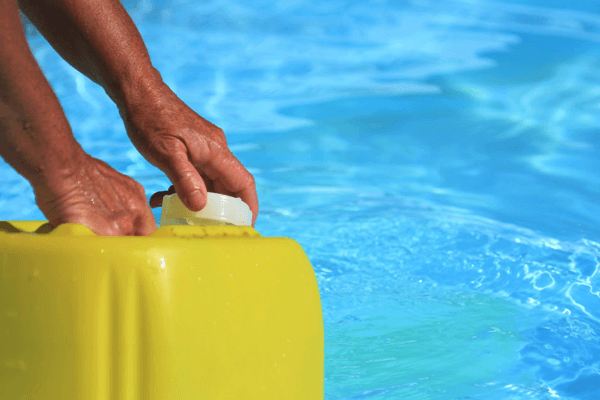The most well-known and effective way of killing the bacteria and algae of a pool is the shocking method. Clean water not only brings an amazing view, but also, it is enjoyable to spread out your hands and legs to swim.
It has mainly two parts— chlorination and filtration. Once you are done with disinfecting, you will need to pump the water out to remove the dead algae and other microbes, but if your pool pump is out of service, can you shock a pool without the pump running?
Well, you can skip the filtration process as an alternative way of cleaning your pool for a short time period. It won’t work if you don’t pump the pool after a few days of shock.
Contents
How to Shock a Pool without the Pump Running
Shocking is one of the most effective methods of cleaning a pool that requires pumping and circulating the water to work properly. However, if your pump is doing malfunctions, there are some alternative ways to shock the pool, but the methods are not as effective as using a pump.
- Firstly, you will need to determine the shocking amount according to the amount of water your pool can reserve. Pour the shock into the pool water and leave it for a while.
- It is recommended to follow the instructions given by the manufacturer. You can leave the shock overnight. Make sure to disinfect the water.
- Use multi-action chlorines that will completely disinfect the pool water. Also, use anti-algae solutions to kill the microbes.
- Adding flocculant is also useful to help the dirt and particles falling to the bottom so that you can clean them with pool cleaner.
- Balance the pH level of the pool. Monitor the pH continuously with a pH tester otherwise, the chlorine won’t work effectively. The normal pH level of a pool is 7.2-7.7
- Chlorination is a must to disinfect the pool and keep it fresh in summer. It is one of the most inexpensive formulas that quickly destroys fungi, bacteria and other microorganisms. Keep the amount in between 0.6-1.5 mg/dl in the pool water.
- Also, you can invest in treatment kits containing anti-algae products, chlorine, active oxygen tablets, flocculant, and pH test strips.
- You can mix the solutions manually using a pole or a leaf net, or anything that makes the water moving.
- Purchase a chlorine diffuser as the water remains in a frozen-like condition without filtration. So, the chlorine won’t dissolve without a diffuser.
- Do not throw chlorine directly to the pool. Place it properly in the diffuser and apply it to prevent the liner damage.
- In the case of free-standing pools, drain the water at least once a month and for the inflatable ones, do it once a week.
- You can use the dirty and untreated pool water for watering your garden to avoid mess.
- If your pool is large, spread liquid chlorine to the water and circulate it manually with a paddle or telescopic pole to disperse the chlorine.
These guidelines and steps you can follow to keep your pool algae-free and crystal-clear without running the pump after shocking. Do not forget to test the chlorine level and pH of the water. Before anyone jumps into the pool, the water must return to normal condition.
Why and when to shock your pool
You need to shock your pool if the chlorine level decreases by the sun up to 5mm in a day. Also, normal chlorine concentration can not stand against chemicals of hair and makeup products, perfumes, bacteria, lotions, etc. Moreover, heavy rainfall can dilute the chlorine concentration in the pool. That’s why you need to keep the normal chlorine level in your pool.
When the chlorine concentration drops at 3ppm or, after heavy rain, heavy pool usage you should shock the pool. Also, before covering for winter or, using after season, and when the spotting algae start to appear, shock the pool to keep it clean.
Should I run the pump after shocking?
Yes, you should. It is recommended to run the pump for 24 hours to make sure that the shock is mixed thoroughly in the pool. Also, it will help the filter to remove germs or dead algae that are killed by shocking. However, if you don’t want to pump the pool 24 hours continuously, you have to pump for at least 6 hours, otherwise the water flow will decrease resulting in decreased filtration and blooming of algae.
Should I pump the pool constantly?
It is recommended to run your pool pump and filtrate the water once every 24 hours, but it is not necessary to keep the pump in service all the time. You can run the pool pump several times for a few moments in a day instead of running it all day long.
Why does the pool still look green even after shocking?
The pool may still be green after shocking due to lack of maintenance of the pool chemicals. If the chemicals are not maintained properly, the pH level gets imbalanced easily, as a result the pool starts looking greenish. Do not forget to add some phosphate (stabilizer) removers after shocking.
Conclusion
You can shock the pool without running the pump, but the process will not be that effective. This method will work for a few days without creating any issue, in case your water pump is out of service. Try to fix the pump as soon as possible, otherwise there will be budding of algae and other microbes or green growth blossom within a few days. Along these lines, it’s ideal to have your siphon prepared as quickly as time permits.

